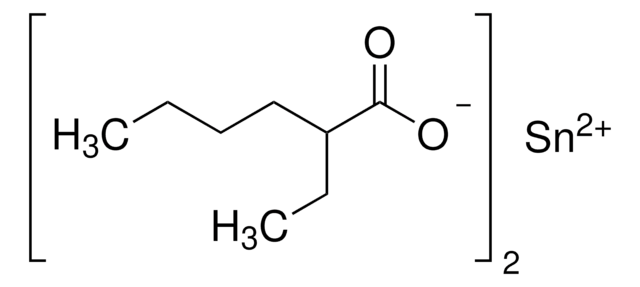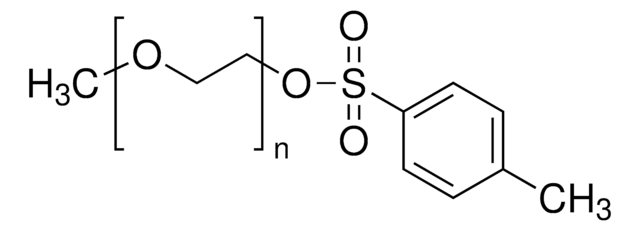202509
Poly(ethylene glycol) methyl ether
average Mn 2,000, methoxy, hydroxyl
Sinonimo/i:
Polyethylene glycol monomethyl ether
Autenticatiper visualizzare i prezzi riservati alla tua organizzazione & contrattuali
About This Item
Formula condensata:
CH3(OCH2CH2)nOH
Numero CAS:
Numero MDL:
Codice UNSPSC:
12162002
ID PubChem:
NACRES:
NA.23
Prodotti consigliati
product name
Poly(ethylene glycol) methyl ether, average Mn ~2,000
Densità del vapore
>1 (vs air)
Livello qualitativo
Tensione di vapore
0.05 mmHg ( 20 °C)
Forma fisica
flakes (or pellets)
PM
average Mn ~2,000
Viscosità
54.6 cSt(210 °F)(lit.)
Temp. transizione
Tm 52 °C
Gruppo funzionale
hydroxyl
InChI
1S/C3H8O2/c1-5-3-2-4/h4H,2-3H2,1H3
XNWFRZJHXBZDAG-UHFFFAOYSA-N
Cerchi prodotti simili? Visita Guida al confronto tra prodotti
Categorie correlate
Descrizione generale
It is a Polyethylene glycol (PEG) macromer with a reactive chain end consisting of methyl ether. Etherification of the PEG chain ends can be undertaken in basic conditions by reacting it with alkyl halides. mPEG can undergo cross linking to form hydrogels; polymerization can be initiated by redox reaction or free radical initiator.
Applicazioni
Poly(ethylene glycol) methyl ether-attached dendrimers can be used as carriers for anticancer drugs. This novel drug carrier has a biocompatible surface and an interior for the encapsulation of drugs.
It can be used as a pore-forming agent in the preparation of ultrafiltration membranes which are used in the removal of macromolecules.
It can also be used as a starting material in the preparation of a biodegradable amphiphilic copolymer of poly(L-alanine) with mPEG.
It can be used as a pore-forming agent in the preparation of ultrafiltration membranes which are used in the removal of macromolecules.
It can also be used as a starting material in the preparation of a biodegradable amphiphilic copolymer of poly(L-alanine) with mPEG.
Caratteristiche e vantaggi
Inserting poly(ethylene glycol) methyl ether (mPEG) side chain enhances the hydrophilicity and flexibility of the polymer matrix.
Codice della classe di stoccaggio
11 - Combustible Solids
Classe di pericolosità dell'acqua (WGK)
WGK 1
Punto d’infiammabilità (°F)
359.6 °F - closed cup
Punto d’infiammabilità (°C)
182 °C - closed cup
Dispositivi di protezione individuale
Eyeshields, Gloves
Scegli una delle versioni più recenti:
Possiedi già questo prodotto?
I documenti relativi ai prodotti acquistati recentemente sono disponibili nell’Archivio dei documenti.
I clienti hanno visto anche
Yi Wei et al.
Langmuir : the ACS journal of surfaces and colloids, 28(39), 13984-13992 (2012-09-04)
The microcosmic mechanisms of protein (recombinant human growth hormone, rhGH) incomplete release and stability from amphiphilic poly(monomethoxypolyethylene glycol-co-D,L-lactide) (mPEG-PLA, PELA) microspheres were investigated. PELA with different hydrophilicities (PELA-1, PELA-2, and PELA-3) based on various ratios of mPEG to PLA were
Prakash G Avaji et al.
Bioorganic & medicinal chemistry letters, 23(6), 1763-1767 (2013-02-16)
Saturated fatty acids (FA) were grafted using tyrosine as a spacer group to the cyclotriphosphazene ring along with equimolar hydrophilic methoxy poly(ethylene glycol) (MPEG) in cis-nongeminal way. Seven new cyclotriphosphazene amphiphiles were prepared from combinations of hydrophilic MPEGs with different
Mulu Z Tesfay et al.
Journal of virology, 87(7), 3752-3759 (2013-01-18)
We are developing oncolytic vesicular stomatitis viruses (VSVs) for systemic treatment of multiple myeloma, an incurable malignancy of antibody-secreting plasma cells that are specifically localized in the bone marrow. One of the presumed advantages for using VSV as an oncolytic
Seung-Young Lee et al.
Biomaterials, 34(2), 552-561 (2012-10-20)
Although targeted delivery mediated by ligand modified or tumor microenvironment sensitive nanocarriers has been extensively pursued for cancer chemotherapy, the efficiency is still limited by premature drug release after systemic administration. Herein we report a highly blood-stable, tumor-adaptable drug carrier
Junming Li et al.
Journal of biomedical nanotechnology, 8(5), 809-817 (2012-08-15)
In this study, quercetin (QC) with cancer chemoprevention effect and anticancer potential was loaded into polymeric micelles of methoxy poly(ethylene glycol)-cholesterol conjugate (mPEG-Chol) in order to increase its water solubility. MPEG-Chol with lower critical micelle concentration (CMC) value (4.0 x
Il team dei nostri ricercatori vanta grande esperienza in tutte le aree della ricerca quali Life Science, scienza dei materiali, sintesi chimica, cromatografia, discipline analitiche, ecc..
Contatta l'Assistenza Tecnica.





